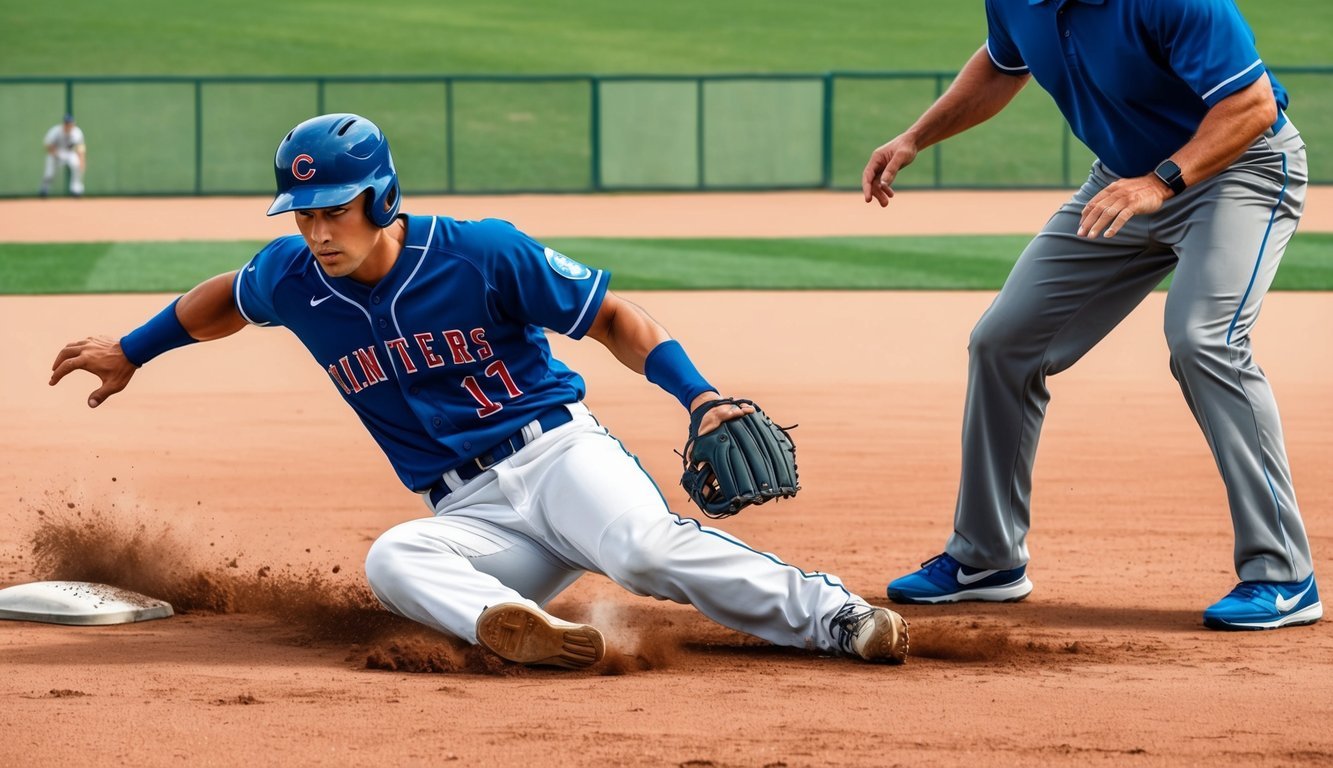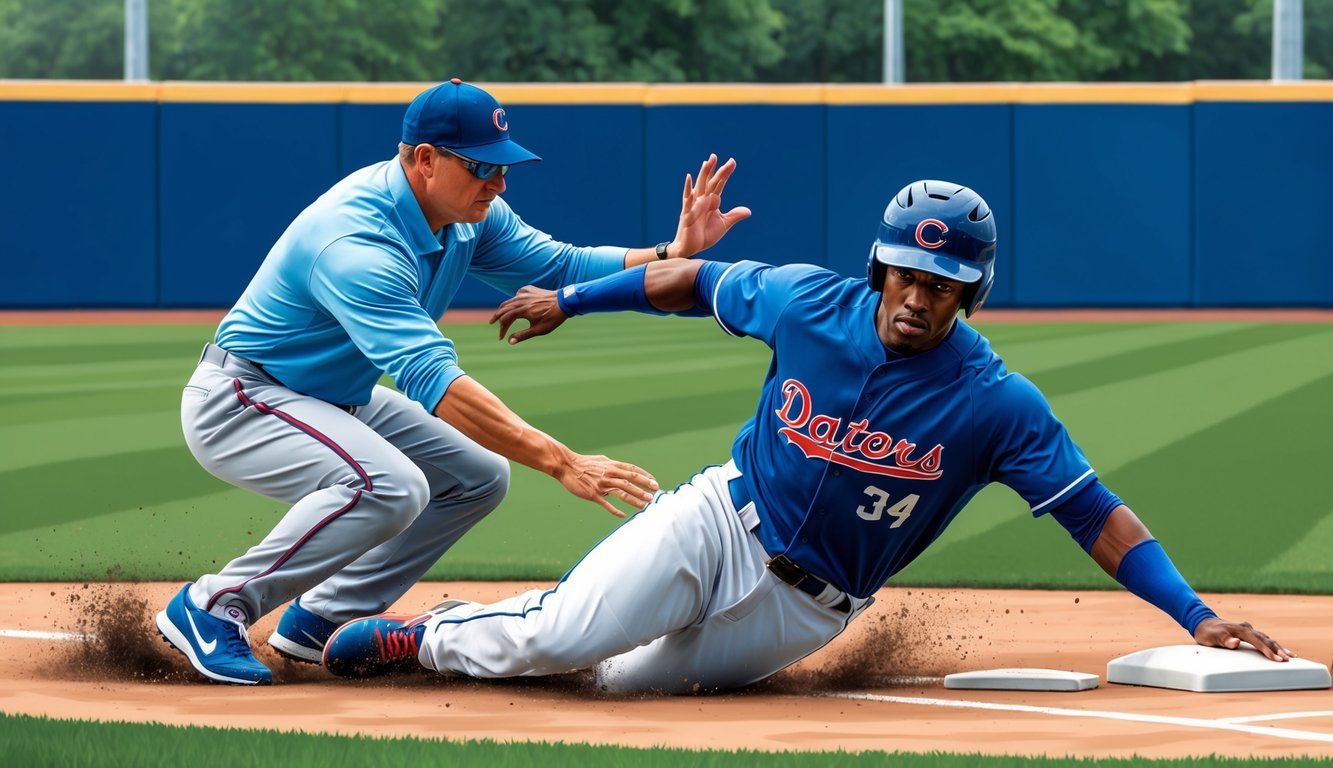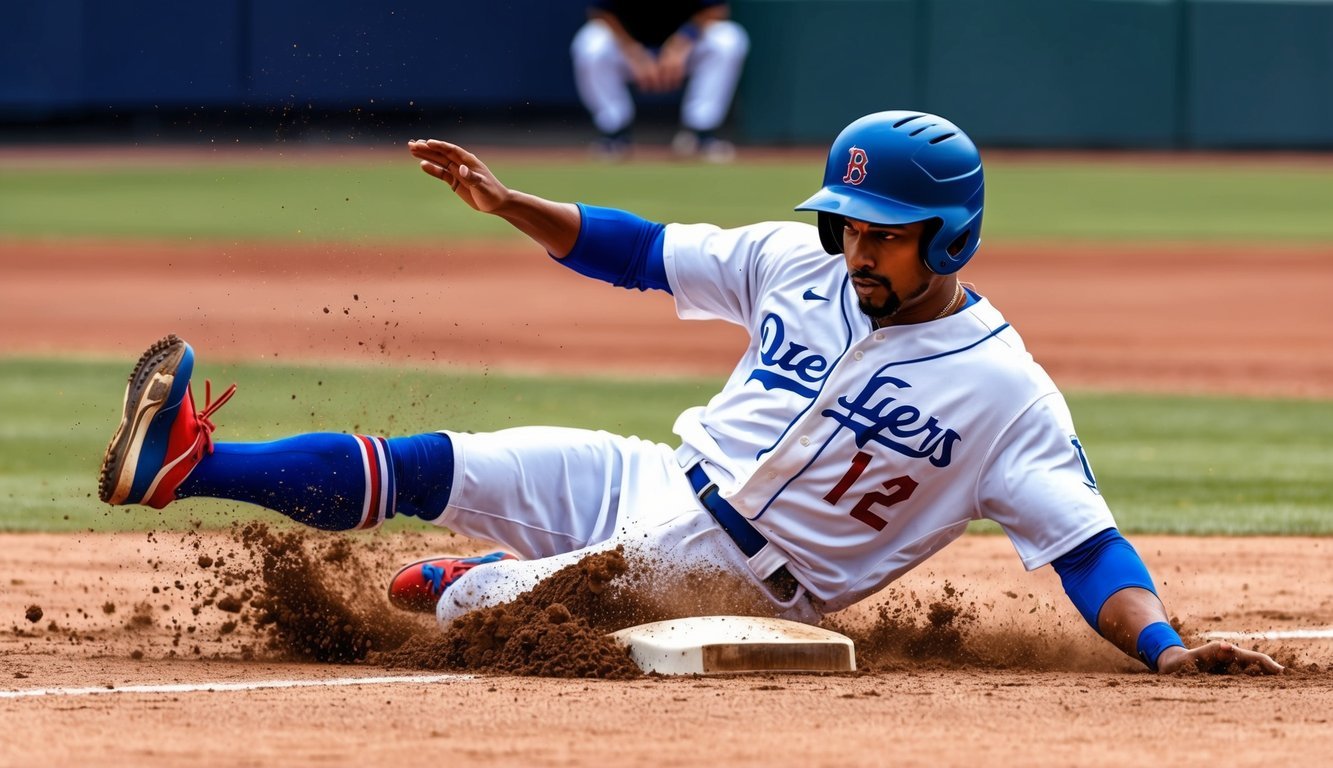Learning to slide properly is an essential skill for any baseball player looking to advance their game.
A well-executed slide can mean the difference between being safe or out, potentially changing the course of an entire game. The key to a successful baseball slide is timing, form, and practice.
Sliding in baseball involves more than just dropping to the ground.
It requires proper technique to maximize speed while minimizing the risk of injury.
Players need to approach the base at the right angle, tuck their legs correctly, and use their hands for balance and protection.
With the right form, athletes can slide smoothly into bases, evading tags and avoiding collisions with fielders.
Safety is paramount when learning to slide.
Proper instruction and supervised practice help players develop this skill safely.
Many coaches start by teaching sliding techniques on softer surfaces before moving to the diamond.
As players gain confidence and refine their technique, sliding becomes a valuable tool in their baseball arsenal.
Understanding the Basics of Sliding
Sliding is a crucial skill in baseball that can make the difference between being safe or out.
It requires proper technique, timing, and practice to execute effectively.
Types of Baseball Slides
The bent-leg slide is the most common type used in baseball.
Players keep one leg bent underneath while extending the other toward the base.
This slide provides a good balance of speed and control.
The hook slide is useful for avoiding tags.
The runner slides to the outside of the base, reaching back with their hand to touch it.
This technique can be effective when trying to evade a fielder’s glove.
Pop-up slides allow runners to quickly transition from sliding to running.
Players use this when they might need to advance to the next base immediately after reaching one safely.
Head-first slides can be faster but carry a higher risk of injury.
Some coaches discourage this technique, especially for younger players.
When to Slide in a Game
Runners should slide when the play at a base is likely to be close.
This reduces the chance of overrunning the bag and helps avoid collisions with fielders.
Sliding is often necessary when stealing bases.
The extra speed gained from diving can make the difference in beating a throw from the catcher.
During a double play attempt, the lead runner may slide to break up the play and prevent a clean throw to first base.
Players should also slide when returning to a base on a pickoff attempt.
This makes it harder for the fielder to apply a tag.
Sliding Rules and Regulations
Major League Baseball has specific rules about sliding to ensure player safety.
Runners must make a “bona fide slide,” which involves: Runners must make a “bona fide slide,” which involves maintaining contact with the ground and avoiding interference with the fielder.
If a runner does not execute a proper slide, they may be called out for violating the rules, thus emphasizing the importance of safe play.
Additionally, wrc explained in baseball highlights how slide rules help protect players from injury while promoting fair competition on the field.
- Sliding before reaching the base
- Being able to and attempting to reach the base with their hand or foot
- Being able to and attempting to remain on the base after the slide
- Sliding within reach of the base without changing their pathway to make contact with a fielder
Excessive contact or interference with a fielder can result in the runner being called out.
This includes deliberately sliding into a fielder to break up a play.
Runners are not allowed to slide beyond the base.
Oversliding can lead to being tagged out if they lose contact with the bag.
Fundamentals of a Proper Slide
Mastering the art of sliding in baseball requires proper technique, practice, and awareness of key safety considerations.
A well-executed slide can make the difference between being safe or out on the basepaths.
Executing a Feet-First Slide
The feet-first slide is the most common and safest sliding technique in baseball.
To perform it effectively, approach the base at full speed.
About 3-4 strides away, lower your center of gravity by bending your knees slightly.
As you begin to slide, extend one leg forward and tuck the other underneath.
Keep your hands up and away from the ground to avoid injury.
Aim to make contact with the base using the foot of your extended leg.
As you slide, turn your head to the side to protect your face from kicked-up dirt or debris.
Practice on grass or a sliding mat before attempting on dirt or turf.
This helps build confidence and muscle memory for game situations.
Mastering the Head-First Slide
While riskier, the head-first slide can be faster and more effective in certain situations.
To execute it safely, keep your chin tucked and arms extended in front of you.
Lead with your hands, palms down, fingers spread to absorb impact.
As you slide, keep your body straight and parallel to the ground.
Aim to contact the base with your hands first.
To avoid injury, never slide head-first into home plate where collisions with catchers are more likely.
Head-first slides require more practice and should only be used by experienced players who have mastered the technique on softer surfaces first.
Avoiding Common Sliding Mistakes
Many sliding errors stem from poor technique or hesitation.
Slowing down before sliding reduces momentum and increases injury risk.
Keep your arms and hands off the ground during feet-first slides.
Dragging them can lead to jammed fingers or wrists.
For head-first slides, avoid reaching back for the base, which can strain shoulders.
Don’t slide too early or too late.
Time your slide to arrive at the base just as your lead foot or hand makes contact.
Sliding too soon wastes momentum, while sliding too late risks oversliding the base.
Practice proper sliding form regularly to build muscle memory and confidence.
This helps reduce hesitation and improves execution in game situations.
Advanced Sliding Techniques

Mastering advanced sliding techniques can give players a significant edge on the basepaths.
These methods require practice and perfect timing to execute effectively in game situations.
Performing the Hook Slide
The hook slide is a crafty technique used to avoid tags at bases.
As the player approaches the base, they slide feet-first but curve their body away from the fielder.
This creates a hook shape, making it harder for defenders to apply the tag.
To execute a hook slide:
- Approach the base at full speed
- Start the slide slightly earlier than normal
- Swing the legs to one side, creating an arc
- Reach for the base with the hand opposite the slide direction
This technique works well when trying to avoid a tag at second or third base.
It’s particularly effective against infielders positioned on the opposite side of the bag.
Executing the Pop-Up Slide
The pop-up slide allows runners to transition quickly from sliding to running.
It’s useful when there’s a possibility of advancing to the next base due to an overthrow or fielding error.
Key steps for a pop-up slide:
- Initiate a feet-first slide
- Keep the back leg bent underneath
- Use the momentum to pop up onto the front foot
- Spring into a running position
This slide requires good body control and practice to master.
It’s most commonly used when stealing bases or stretching singles into doubles.
The Art of the Take Out Slide
The take out slide aims to disrupt a fielder’s throw, typically at second base during a double play attempt.
While rules have changed to protect fielders, a clean take out slide can still be effective.
To perform a legal take out slide:
- Begin sliding before reaching the base
- Stay within reach of the bag
- Slide directly into the base, not beyond it
- Avoid making contact above the knee
Players must be careful not to violate interference rules.
The goal is to impede the fielder’s throw without causing injury or breaking regulations.
Slide Training and Drills

Mastering the art of sliding in baseball requires consistent practice and proper technique.
Focused drills help players develop muscle memory, boost confidence, and reduce injury risk.
Essential Drills for Beginners
Beginners should start with basic sliding drills to build a strong foundation.
The standing slide drill is an excellent starting point.
Players stand still, then drop into a sliding position.
This helps them learn the correct body positioning without the added complexity of movement.
Next, introduce the walk-and-slide drill.
Players walk a few steps before sliding, focusing on proper form.
As they improve, increase the speed to a jog.
The pop-up slide drill teaches quick recovery.
Players slide and immediately pop up to a standing position, simulating game situations where they might need to advance to the next base.
Training on Soft Surfaces
Practicing on soft surfaces is crucial for safety and comfort.
Grass or turf provides natural cushioning for beginners.
As players advance, coaches can use sliding mats or tarps to create a more realistic base-sliding experience.
Beach sand offers an excellent training ground.
Its forgiving nature allows players to practice without fear of injury.
The resistance of sand also helps build leg strength.
For indoor training during off-seasons, gymnastics mats or foam pits can be useful alternatives.
These surfaces let players focus on technique without worrying about scrapes or bruises.
Using Props for Sliding Practice
Props enhance sliding practice by adding realism and challenge.
Cardboard boxes serve as makeshift bases, teaching players to aim for a specific target.
Coaches can adjust the box positions to simulate different sliding scenarios.
Plastic bases with anchors mimic real field conditions.
They help players learn to judge distances and practice touching the base while sliding.
Water slides are a fun way to practice on hot days.
The slippery surface encourages proper form and reduces friction, allowing players to focus on their sliding technique.
Video analysis tools let coaches and players review form in slow motion.
This visual feedback is invaluable for identifying areas for improvement and reinforcing correct techniques.
Staying Safe While Sliding

Sliding safely in baseball requires proper technique and awareness.
Players should tuck their chin to protect their head and neck during the slide.
Keeping hands up and away from the ground reduces the risk of finger and wrist injuries.
The sliding position should engage the core muscles for stability.
Baserunners need to be mindful of their distance from the base when starting their slide.
Slowing down slightly before sliding helps maintain control.
Youth players should practice sliding techniques on softer surfaces before attempting on the field.
Coaches can use sliding mats for safe training.
Proper footwear is crucial.
Avoid metal spikes, as they can cause injuries during collisions or when sliding into a base.
Players should be aware of their surroundings, including other players and umpires, to prevent unexpected collisions.
Teams can incorporate sliding drills into regular practice sessions to improve technique and build confidence in players.
